air condition MAZDA MODEL CX-7 2007 Owners Manual (in English)
[x] Cancel search | Manufacturer: MAZDA, Model Year: 2007, Model line: MODEL CX-7, Model: MAZDA MODEL CX-7 2007Pages: 406, PDF Size: 6.11 MB
Page 3 of 406
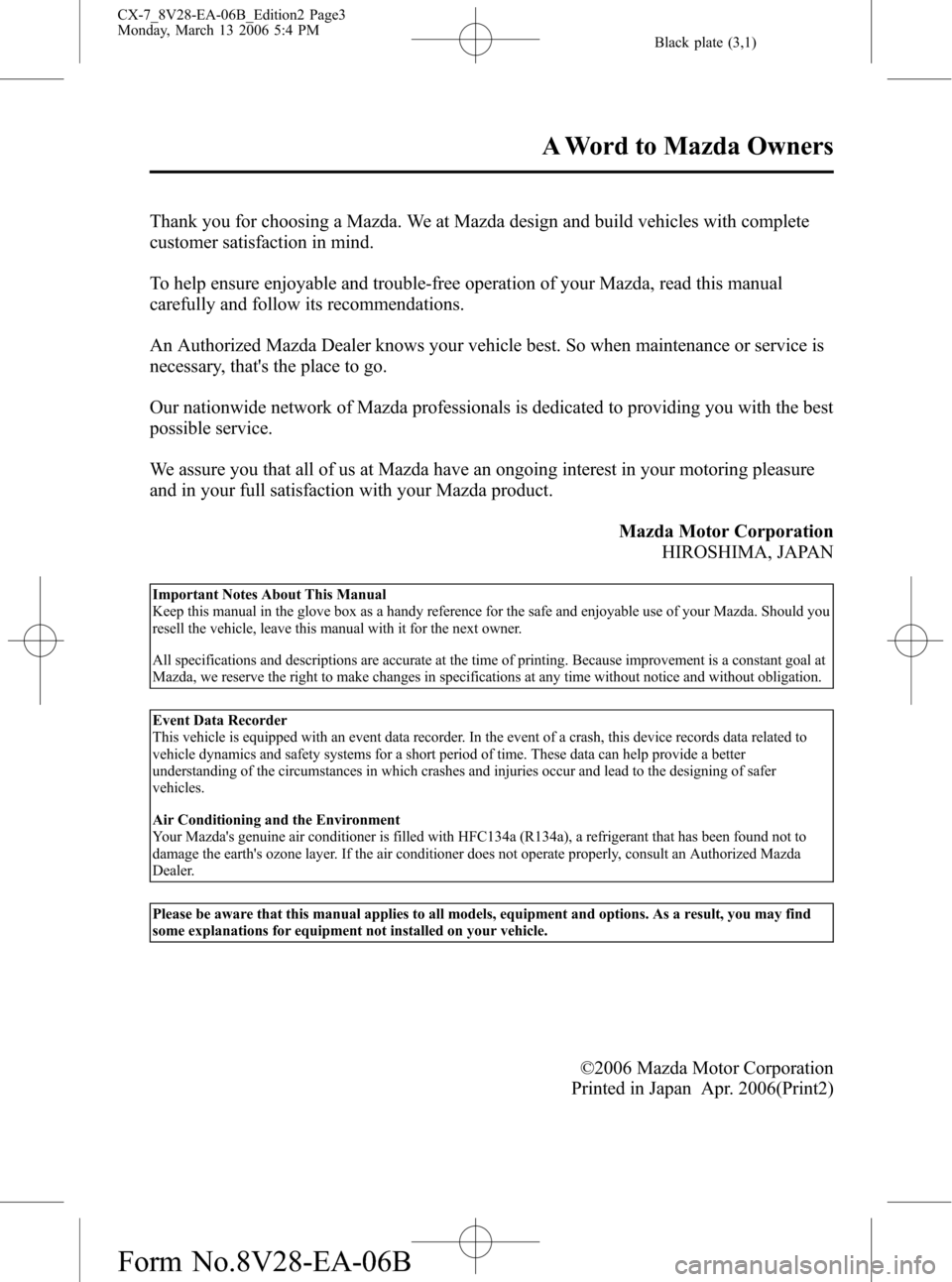
Black plate (3,1)
Thank you for choosing a Mazda. We at Mazda design and build vehicles with complete
customer satisfaction in mind.
To help ensure enjoyable and trouble-free operation of your Mazda, read this manual
carefully and follow its recommendations.
An Authorized Mazda Dealer knows your vehicle best. So when maintenance or service is
necessary, that's the place to go.
Our nationwide network of Mazda professionals is dedicated to providing you with the best
possible service.
We assure you that all of us at Mazda have an ongoing interest in your motoring pleasure
and in your full satisfaction with your Mazda product.
Mazda Motor Corporation
HIROSHIMA, JAPAN
Important Notes About This Manual
Keep this manual in the glove box as a handy reference for the safe and enjoyable use of your Mazda. Should you
resell the vehicle, leave this manual with it for the next owner.
All specifications and descriptions are accurate at the time of printing. Because improvement is a constant goal at
Mazda, we reserve the right to make changes in specifications at any time without notice and without obligation.
Event Data Recorder
This vehicle is equipped with an event data recorder. In the event of a crash, this device records data related to
vehicle dynamics and safety systems for a short period of time. These data can help provide a better
understanding of the circumstances in which crashes and injuries occur and lead to the designing of safer
vehicles.
Air Conditioning and the Environment
Your Mazda's genuine air conditioner is filled with HFC134a (R134a), a refrigerant that has been found not to
damage the earth's ozone layer. If the air conditioner does not operate properly, consult an Authorized Mazda
Dealer.
Please be aware that this manual applies to all models, equipment and options. As a result, you may find
some explanations for equipment not installed on your vehicle.
©2006 Mazda Motor Corporation
Printed in Japan Apr. 2006(Print2)
A Word to Mazda Owners
CX-7_8V28-EA-06B_Edition2 Page3
Monday, March 13 2006 5:4 PM
Form No.8V28-EA-06B
Page 5 of 406
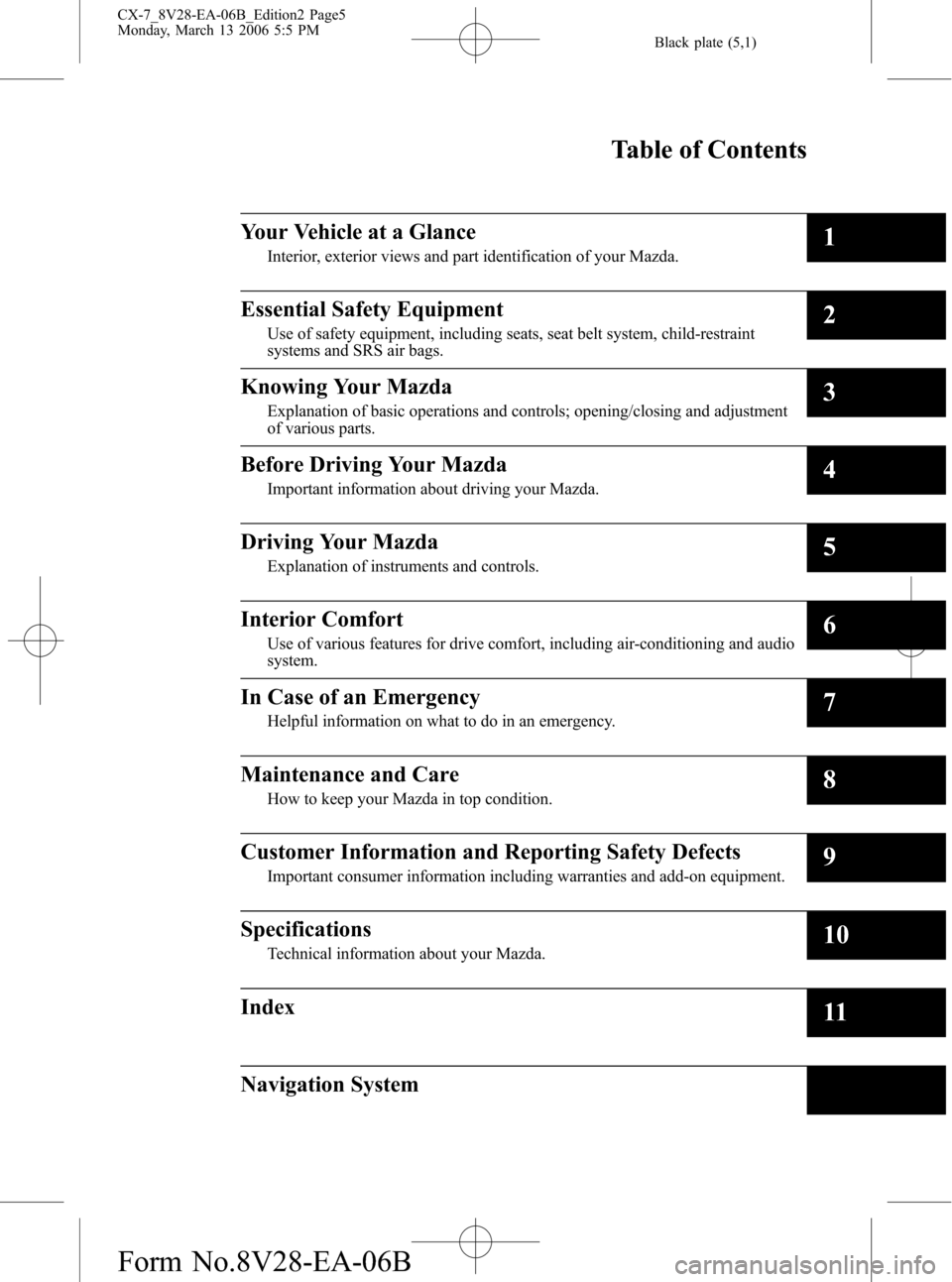
Black plate (5,1)
CX-7_8V28-EA-06B_Edition2 Page5
Monday, March 13 2006 5:5 PM
Form No.8V28-EA-06B
Table of Contents
Your Vehicle at a Glance
Interior, exterior views and part identification of your Mazda.1
Essential Safety Equipment
Use of safety equipment, including seats, seat belt system, child-restraint
systems and SRS air bags.2
Knowing Your Mazda
Explanation of basic operations and controls; opening/closing and adjustment
of various parts.3
Before Driving Your Mazda
Important information about driving your Mazda.4
Driving Your Mazda
Explanation of instruments and controls.5
Interior Comfort
Use of various features for drive comfort, including air-conditioning and audio
system.6
In Case of an Emergency
Helpful information on what to do in an emergency.7
Maintenance and Care
How to keep your Mazda in top condition.8
Customer Information and Reporting Safety Defects
Important consumer information including warranties and add-on equipment.9
Specifications
Technical information about your Mazda.10
Index11
Navigation System
Page 41 of 406

Black plate (41,1)
WARNING
Avoid putting a front-facing child-restraint system on the front passenger seat:
A front-facing child-restraint system should only be put on the front seat when it is
unavoidable. In a collision, the force of a deploying air bag could cause serious injury
or death to the child. Always move the seat as far back as possible.
Seating a child in a child-restraint system on the front passenger seat is dangerous:
Your vehicle is equipped with front passenger seat weight sensors. Even with front
passenger seat weight sensors, if you must use the front passenger seat to seat a child,
using a child-restraint system on the front passenger seat under the following
conditions increases the danger of the front passenger air bag deploying and could
result in serious injury or death to the child.
lThe total seated weight of the child with the child-restraint system on the front
passenger seat is approximately 30 kg (66 lb) or more with a child in the child-
restraint system.
lLuggage or other items are placed on the seat with the child in the child-restraint
system.
lA rear passenger or luggage pushing or pulling down on the front passenger
seatback.
lA rear passenger puts their feet on the front seat rails.lLuggage or other items are placed on the seatback or hung on the head restraint.lThe seat is washed.lLiquids are spilled on the seat.lThe front passenger seat is moved backward, pushing into luggage or other items
placed behind it.
lThe front passenger seatback contacts the rear seat.lLuggage or other items are placed between the front passenger seat and driver seat.lAny accessories increasing the total seated weight on the front passenger seat are
attached to the front passenger seat.
The designated positions with seat belts on the rear seats are the safest places for
children. Always use seat belts and child restraints.
Essential Safety Equipment
Child Restraint
2-29
CX-7_8V28-EA-06B_Edition2 Page41
Monday, March 13 2006 5:5 PM
Form No.8V28-EA-06B
Page 67 of 406

Black plate (67,1)
SRS Air Bag Deployment Criteria
This chart indicates the applicable SRS equipment that will deploy depending on the type of collision.
(The illustrations are the representative case of collisions.)
SRS
equipmentTypes of collision
A severe frontal/near frontal
collisionA severe side
collisionA roll-over/near
roll-overA rear collision
Front seat
belt
pretensionerX*(both sides) X*(both sides)
No air bag and front
seat belt
pretensioner will be
activated in a rear
collision. Driver air
bagX
Front
passenger air
bagX
*
Side air bagX*(impact side only)
Curtain air
bagX (impact side only) X (both sides)
X: The SRS air bag equipment is designed to deploy in a collision.
*: The front passenger front and side air bags and the seat belt pretensioner are designed to deploy depending on
the condition of the total seated weight on the front passenger seat.
Essential Safety Equipment
SRS Air Bags
2-55
CX-7_8V28-EA-06B_Edition2 Page67
Monday, March 13 2006 5:5 PM
Form No.8V28-EA-06B
Page 71 of 406

Black plate (71,1)
Front passenger air bag deactivation indicator light
This indicator light illuminates to remind you that the front passenger front and side air
bags and seat belt pretensioner will not deploy during a collision.
If the front passenger weight sensors are normal, the indicator light illuminates when the
ignition switch is turned to the ON position. For a specified of time it goes out.
The front passenger air bag deactivation indicator light illuminates or is off under the following conditions:
Total seated weight on the
front passenger seatFront passenger air bag
deactivation indicator lightFront passenger front and
side air bagsFront passenger seat
belt pretensioner
system
Empty (Not occupied)
*OFF Deactivated Deactivated
Less than approx. 30 kg
(66 lb)ON Deactivated Deactivated
Approx. 42 kg (93 lb) or
moreOFF Ready Ready
* If the front passenger seat belt is buckled, the front passenger air bag deactivation indicator light illuminates,
however this does not indicate a malfunction.
Curtain air bag is ready for inflating despite the chart above.
If the front passenger air bag deactivation indicator light does not illuminate when the
ignition switch is turned to the ON position and does not illuminate as indicated in the
above chart, do not allow a child to sit in the front passenger seat and consult an
Authorized Mazda Dealer as soon as possible. The system may not work properly in an
accident.
Essential Safety Equipment
SRS Air Bags
2-59
CX-7_8V28-EA-06B_Edition2 Page71
Monday, March 13 2006 5:5 PM
Form No.8V28-EA-06B
Page 72 of 406
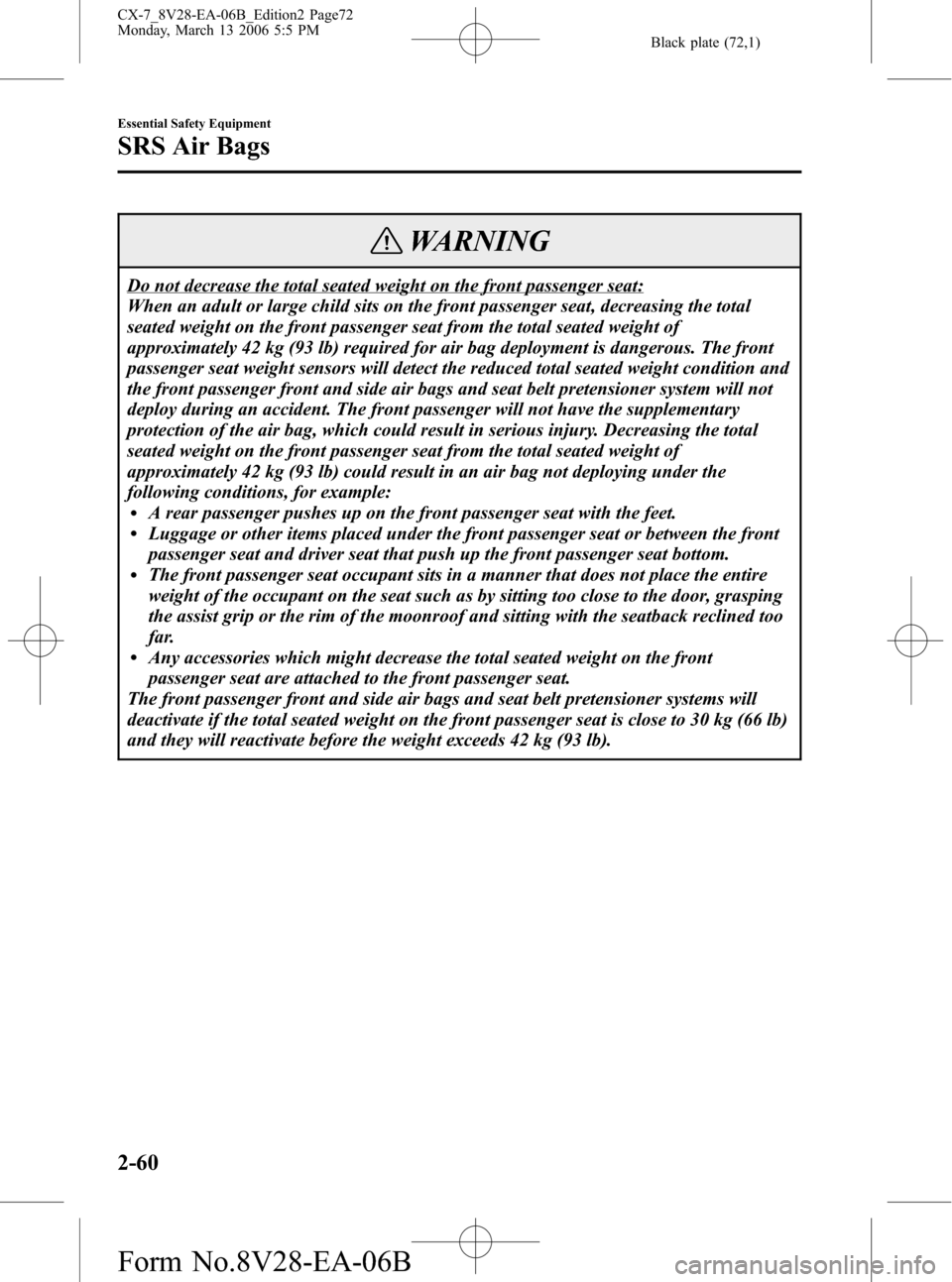
Black plate (72,1)
WARNING
Do not decrease the total seated weight on the front passenger seat:
When an adult or large child sits on the front passenger seat, decreasing the total
seated weight on the front passenger seat from the total seated weight of
approximately 42 kg (93 lb) required for air bag deployment is dangerous. The front
passenger seat weight sensors will detect the reduced total seated weight condition and
the front passenger front and side air bags and seat belt pretensioner system will not
deploy during an accident. The front passenger will not have the supplementary
protection of the air bag, which could result in serious injury. Decreasing the total
seated weight on the front passenger seat from the total seated weight of
approximately 42 kg (93 lb) could result in an air bag not deploying under the
following conditions, for example:
lA rear passenger pushes up on the front passenger seat with the feet.lLuggage or other items placed under the front passenger seat or between the front
passenger seat and driver seat that push up the front passenger seat bottom.
lThe front passenger seat occupant sits in a manner that does not place the entire
weight of the occupant on the seat such as by sitting too close to the door, grasping
the assist grip or the rim of the moonroof and sitting with the seatback reclined too
far.
lAny accessories which might decrease the total seated weight on the front
passenger seat are attached to the front passenger seat.
The front passenger front and side air bags and seat belt pretensioner systems will
deactivate if the total seated weight on the front passenger seat is close to 30 kg (66 lb)
and they will reactivate before the weight exceeds 42 kg (93 lb).
2-60
Essential Safety Equipment
SRS Air Bags
CX-7_8V28-EA-06B_Edition2 Page72
Monday, March 13 2006 5:5 PM
Form No.8V28-EA-06B
Page 73 of 406

Black plate (73,1)
WARNING
Do not increase the total seated weight on the front passenger seat:
When an infant or small child sits on the front passenger seat, increasing the total
seated weight on the front passenger seat from the total seated weight of
approximately 30 kg (66 lb) is dangerous. The front passenger seat weight sensors will
detect the increased total seated weight, which could result in the unexpected
deployment of the front passenger front and side air bags and seat belt pretensioner
system in an accident and may cause serious injury. Increasing the total seated weight
on the front passenger seat beyond the total seated weight of approximately 30 kg (66
lb) could result in the front passenger front and side air bags and seat belt
pretensioner system deployment in an accident under the following conditions, for
example:
lLuggage or other items are placed on the seat with the child in the child-restraint
system.
lA rear passenger or luggage push or pull down on the front passenger seatback.lA rear passenger steps on the front passenger seat rails with the feet.lLuggage or other items are placed on the seatback or hung on the head restraint.lThe seat is washed.lLiquids are spilled on the seat.lThe front passenger seat is moved backward, pushing into luggage or other items
placed behind it.
lThe front passenger seatback contacts the rear seat.lLuggage or other items are placed between the front passenger seat and driver seat.lAny accessories which might increase the total seated weight on the front passenger
seat are attached to the front passenger seat.
The front passenger front and side air bags and seat belt pretensioner systems will
deactivate if the total seated weight on the front passenger seat is close to 30 kg (66 lb)
and they will reactivate before the weight exceeds 42 kg (93 lb).
Essential Safety Equipment
SRS Air Bags
2-61
CX-7_8V28-EA-06B_Edition2 Page73
Monday, March 13 2006 5:5 PM
Form No.8V28-EA-06B
Page 76 of 406
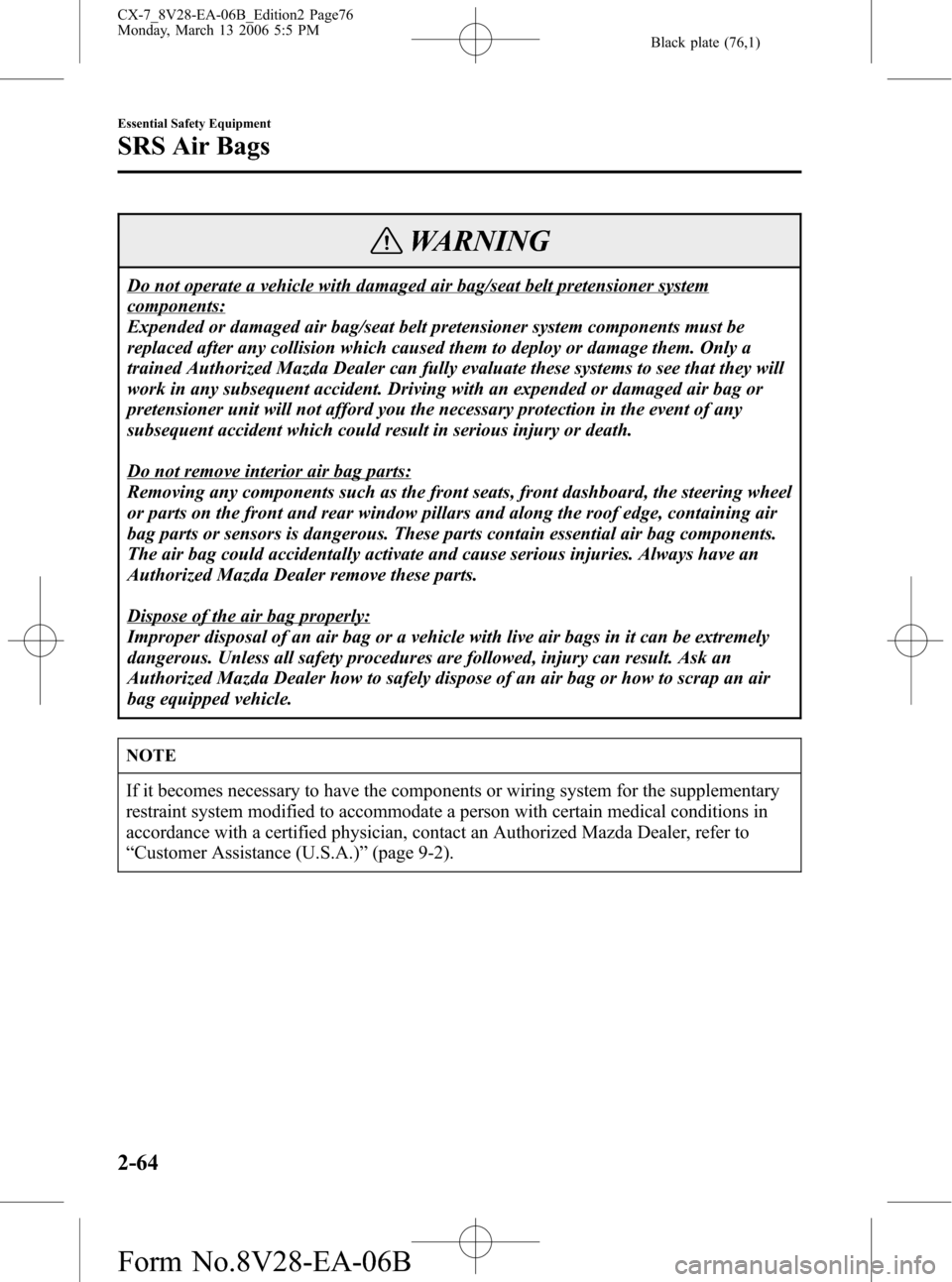
Black plate (76,1)
WARNING
Do not operate a vehicle with damaged air bag/seat belt pretensioner system
components:
Expended or damaged air bag/seat belt pretensioner system components must be
replaced after any collision which caused them to deploy or damage them. Only a
trained Authorized Mazda Dealer can fully evaluate these systems to see that they will
work in any subsequent accident. Driving with an expended or damaged air bag or
pretensioner unit will not afford you the necessary protection in the event of any
subsequent accident which could result in serious injury or death.
Do not remove interior air bag parts:
Removing any components such as the front seats, front dashboard, the steering wheel
or parts on the front and rear window pillars and along the roof edge, containing air
bag parts or sensors is dangerous. These parts contain essential air bag components.
The air bag could accidentally activate and cause serious injuries. Always have an
Authorized Mazda Dealer remove these parts.
Dispose of the air bag properly:
Improper disposal of an air bag or a vehicle with live air bags in it can be extremely
dangerous. Unless all safety procedures are followed, injury can result. Ask an
Authorized Mazda Dealer how to safely dispose of an air bag or how to scrap an air
bag equipped vehicle.
NOTE
If it becomes necessary to have the components or wiring system for the supplementary
restraint system modified to accommodate a person with certain medical conditions in
accordance with a certified physician, contact an Authorized Mazda Dealer, refer to
“Customer Assistance (U.S.A.)”(page 9-2).
2-64
Essential Safety Equipment
SRS Air Bags
CX-7_8V28-EA-06B_Edition2 Page76
Monday, March 13 2006 5:5 PM
Form No.8V28-EA-06B
Page 123 of 406
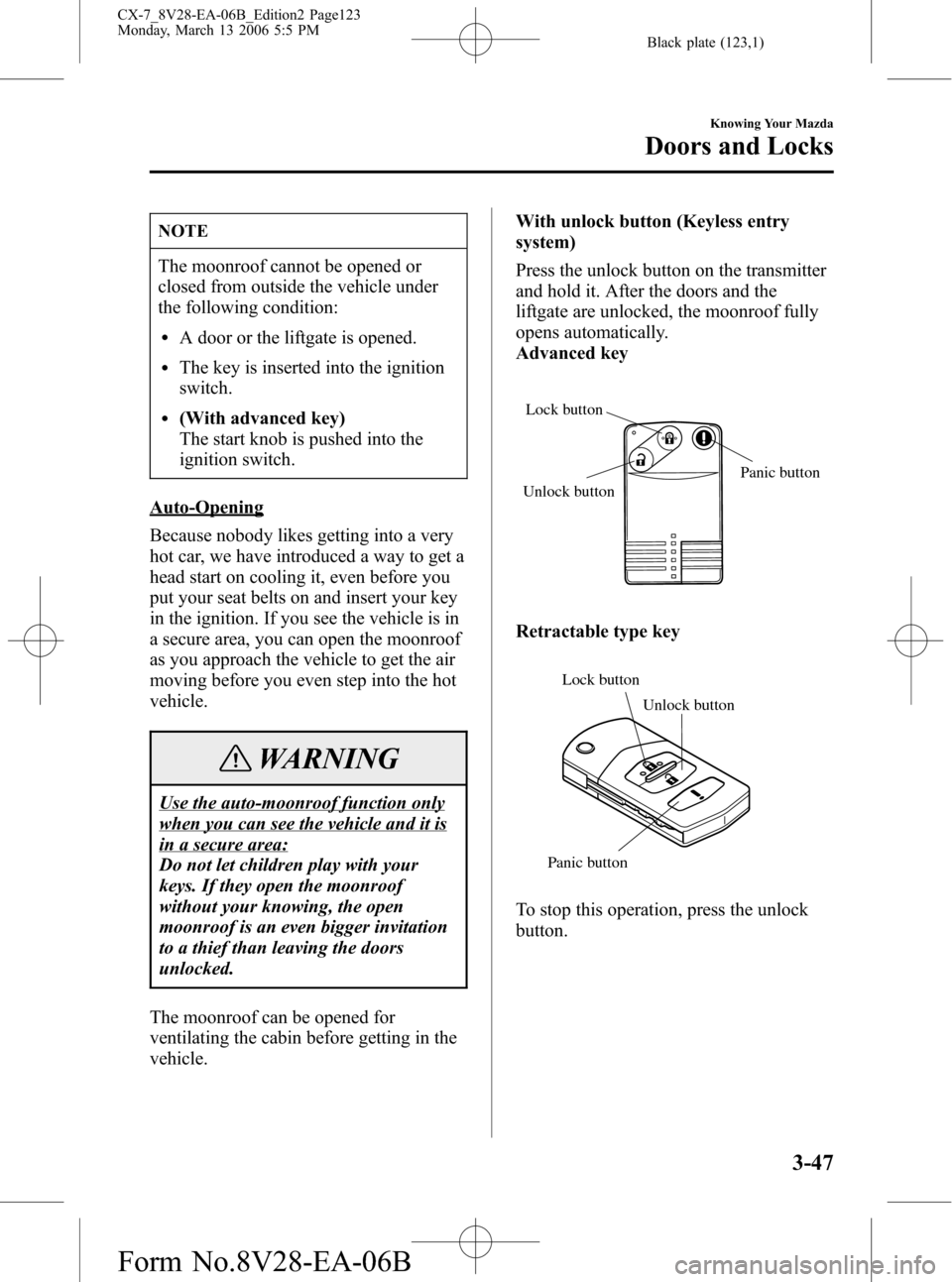
Black plate (123,1)
NOTE
The moonroof cannot be opened or
closed from outside the vehicle under
the following condition:
lA door or the liftgate is opened.
lThe key is inserted into the ignition
switch.
l(With advanced key)
The start knob is pushed into the
ignition switch.
Auto-Opening
Because nobody likes getting into a very
hot car, we have introduced a way to get a
head start on cooling it, even before you
put your seat belts on and insert your key
in the ignition. If you see the vehicle is in
a secure area, you can open the moonroof
as you approach the vehicle to get the air
moving before you even step into the hot
vehicle.
WARNING
Use the auto-moonroof function only
when you can see the vehicle and it is
in a secure area:
Do not let children play with your
keys. If they open the moonroof
without your knowing, the open
moonroof is an even bigger invitation
to a thief than leaving the doors
unlocked.
The moonroof can be opened for
ventilating the cabin before getting in the
vehicle.With unlock button (Keyless entry
system)
Press the unlock button on the transmitter
and hold it. After the doors and the
liftgate are unlocked, the moonroof fully
opens automatically.
Advanced key
Panic button
Unlock buttonLock button
Retractable type key
Lock button
Unlock button
Panic button
To stop this operation, press the unlock
button.
Knowing Your Mazda
Doors and Locks
3-47
CX-7_8V28-EA-06B_Edition2 Page123
Monday, March 13 2006 5:5 PM
Form No.8V28-EA-06B
Page 142 of 406

Black plate (142,1)
Break-In Period
No special break-in is necessary, but a few
precautions in the first 1,000 km (600
miles) may add to the performance,
economy, and life of your Mazda.
lDon't race the engine.
lDon't maintain one constant speed,
either slow or fast, for a long period of
time.
lDon't drive constantly at full-throttle or
high engine rpm for extended periods
of time.
lAvoid unnecessary hard stops.
lAvoid full-throttle starts.
lDon't tow a trailer.
Money-Saving Suggestions
How you operate your Mazda determines
how far it will travel on a tank of fuel. Use
these suggestions to help save money on
fuel and repairs.
lAvoid long warm-ups. Once the engine
runs smoothly, begin driving.
lAvoid fast starts.
lKeep the engine tuned. Follow the
maintenance schedule (page 8-3) and
have an Authorized Mazda Dealer
perform inspections and servicing.
lUse the air conditioner only when
necessary.
lSlow down on rough roads.
lKeep the tires properly inflated.
lDon't carry unnecessary weight.
lDon't rest your foot on the brake pedal
while driving.
lKeep the wheels in correct alignment.
lKeep windows closed at high speeds.
lSlow down when driving in crosswinds
and headwinds.
WARNING
Never stop the engine when going
down a hill:
Stopping the engine when going down
a hill is dangerous. This causes the
loss of power steering and power
brake control, and may cause damage
to the drivetrain. Any loss of steering
or braking control could cause an
accident.
4-6
Before Driving Your Mazda
Driving Tips
CX-7_8V28-EA-06B_Edition2 Page142
Monday, March 13 2006 5:6 PM
Form No.8V28-EA-06B